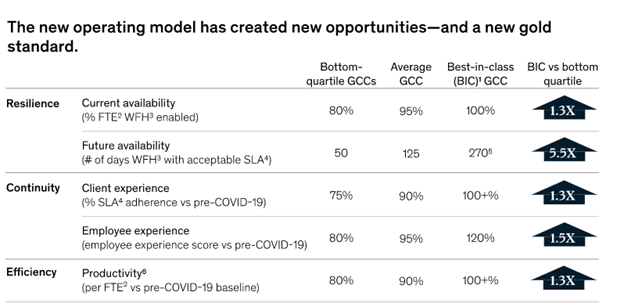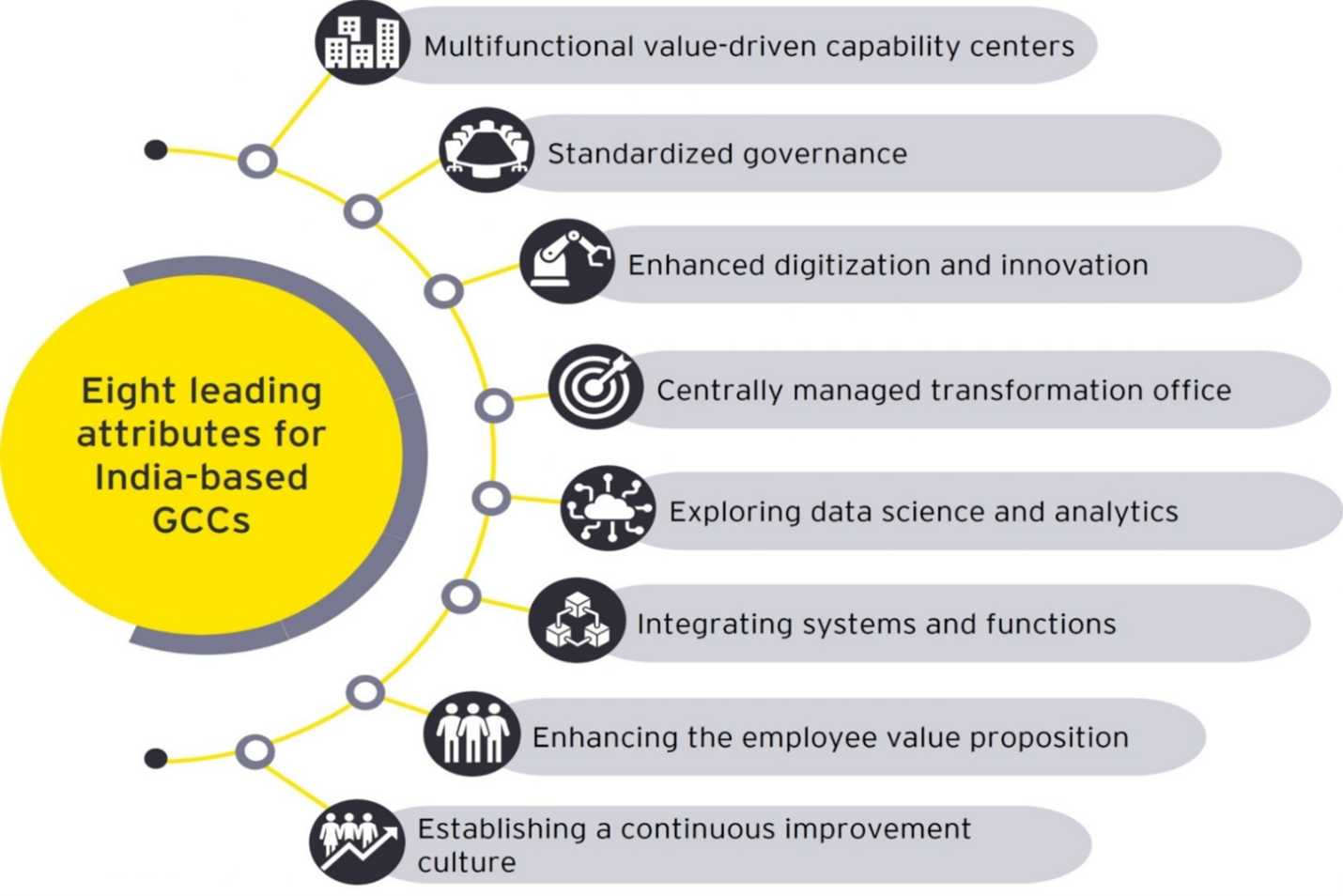
Sign up to receive latest insights & updates in technology, AI & data analytics, data science, & innovations from Polestar Analytics.
Editor's Note: Discover the crucial KPIs for evaluating the success of Global Capability Centers (GCCs) in our latest blog post. Gain insights into aligning KPIs with organizational objectives and leveraging data-driven insights for continuous improvement. Whether you're a business leader or GCC manager, this resource is essential for optimizing performance. Don't miss out on understanding the metrics that drive GCC success.
Over the past three decades, Global Capability Centers (GCCs) have undergone significant transformation, shifting from being single-function Shared Services to multi-functional Global Business Services (GBS) organizations led by digital technology. Today's modern GCCs are equipped to perform complex decision-making tasks while simultaneously streamlining transactional activities through centralization and automation.
By leveraging technology, they are revolutionizing operations to become more flexible and adaptable. These centers are no longer solely focused on cost-saving measures but are instead regarded as strategic partners to enterprises, capable of providing a sustained competitive advantage.
“According to a survey by Deloitte, 75% of companies have plans to expand their GCCs in the next three years. This indicates that businesses see GCCs as an effective way to build operational resilience and achieve strategic goals.”
In today's globalized economy, organizations are increasingly establishing Global Capability Centers (GCCs) to achieve cost savings, drive innovation, and enhance their operational efficiencies. GCCs are an essential part of the company's global footprint and are instrumental in delivering value-added services, technology, and innovation to customers. However, to achieve continuous improvement in operations, GCCs need to identify and measure their Key Performance Indicators (KPIs).

Source: Mckinsey
KPIs are critical metrics that help organizations measure their performance against their objectives, and GCCs are no exception. The right KPIs can provide insights into how well the GCC is functioning, identify areas for improvement, and help in making data-driven decisions. Moreover, KPIs help the GCCs align their operations with the parent company's objectives and drive collaboration between the GCC and other business units.
In this blog, we will discuss the KPIs that GCCs can use to improve their operations and drive continuous improvement.
Through this Ebook harness the strength of Global Capability Centers to propel innovation and fuel digital transformation!
Download E-Book For Free
Continuous improvement is critical to the success of Global Capability Centers (GCCs) as it helps to enhance their operational efficiency, reduce costs, and improve service quality. Key Performance Indicators (KPIs) for continuous improvement strategies help to monitor and measure the effectiveness of the improvement initiatives.
Here are some KPIs for continuous improvement strategies for GCCs with best practices:
1. Process improvement: IT measures the percentage of processes that have been improved or optimized. GCCs should aim to continuously improve their processes to enhance their operational efficiency. Best practices include establishing a process improvement culture, implementing process automation, and conducting regular process audits.
2. Quality improvement: It measures the percentage of improvement in the quality of services delivered by GCCs. GCCs should aim to continuously improve the quality of their services to enhance their operational efficiency. It involves implementing quality control mechanisms, providing adequate training to employees, and conducting regular quality audits.
3. Innovation: According to a survey by Deloitte, 81% of companies reported that their GCCs help them achieve innovations, better business agility, and adaptability. Innovation measures the level of innovation and creativity in continuous improvement initiatives. GCCs should aim to foster a culture of innovation and creativity to enhance the success of their improvement initiatives. Best practices include establishing a process improvement culture, encouraging employee participation in improvement initiatives, and recognizing and rewarding innovative ideas.
4. Process cycle time reduction: measures the percentage of reduction in process cycle time achieved through continuous improvement initiatives. GCCs should aim to reduce process cycle time to enhance their operational efficiency. So that, implementing process automation, identifying process bottlenecks, and continuously improving processes can be smooth.
5. Employee engagement: According to a survey by HfS Research, 80% of GCCs have highly skilled talent that is critical to their parent company's operations. Employee engagement measures the level of engagement and participation of employees in continuous improvement initiatives. GCCs should aim to increase employee engagement to enhance the success of their improvement initiatives. It involves establishing a process improvement culture, providing adequate training to employees, and recognizing and rewarding employee contributions.
6. Customer satisfaction: Customer satisfaction measures the level of satisfaction of customers or end-users with the services provided by GCCs. GCCs should aim to improve customer satisfaction through continuous improvement initiatives. The practices involve implementing a knowledge management system, providing adequate training to employees, and establishing a quality control mechanism.
7. Cost savings: According to a survey by EY, 63% of GCCs help their parent companies achieve cost savings. Cost savings measure the amount of cost savings achieved through continuous improvement initiatives. GCCs should aim to achieve significant cost savings while maintaining or improving quality. It includes implementing process automation, identifying process bottlenecks, and continuously improving processes.
Therefore, measuring the performance of GCCs using KPIs for continuous improvement strategies is essential to monitor and improve the effectiveness of their improvement initiatives. GCCs should adopt best practices to continuously improve their processes, enhance operational efficiency, and achieve long-term sustainability. By doing so, GCCs can contribute to the success of the parent organization and achieve their strategic objectives.
Leverage our analytics consulting solutions for continuous growth and unparalleled KPI success
Connect To Our Analytics ConsultantKey Performance Indicators (KPIs) will continue to play a crucial role in measuring the success of continuous improvement strategies for Global Capability Centers (GCCs) in the future. However, the types of KPIs that GCCs will focus on may evolve based on changing business needs and technological advancements. So, operating a GCC comes with its unique set of challenges, and continuous improvement is critical to the success of GCCs. Continuous improvement strategies can help organizations identify areas for improvement, reduce costs, increase productivity, and improve the overall quality of services provided by the GCC.
The evolving business scenario has propelled companies to pivot to models that ensure resilience, continuity, and efficiency. We, at Polestar Analytics enable organizations to maintain their competitive advantage and optimize their operations. Book a session with us today, to learn how we can assist you survive in a cut-throat competition.
📚 Deepen Your Knowledge! Download Our Free PDF Guide 📚
About Author

Content Architect
The goal is to turn data into information, and information into insights.